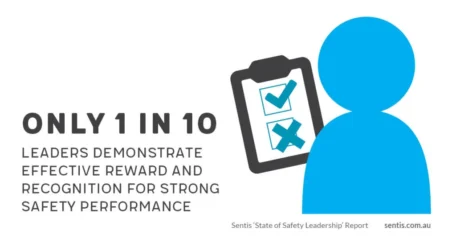Why So Many Safety Leaders Get it Wrong
Tough working environments call for strong leadership. When budgets are tight, pressure to produce is high and workplace culture has historically been tense, leadership focuses on reliable production. ‘Soft skills’ such as reward and recognition are generally not high on the agenda.
What toll does the ineffective use of reward and recognition take on our safety culture and bottom line?
It is an alarming finding that only 24% of leaders demonstrate strong safety leadership behaviours. While we might inherently value strong, effective leadership, the evidence suggests we’re missing the mark.
So, what exactly is strong, effective leadership? Could our assumptions be getting in the way of our end goal?
Common Safety Leadership Myths
You have to treat ’em mean and keep ’em keen
Leaders who see their role as ‘catching out workers’ tend to encourage a safety culture of forced compliance. Workers change their behaviour out of fear when their leader is around, but this form of external motivation is unsustainable and fueled by resentment. This attitude towards leadership is counterproductive to a positive safety culture.
Workers only respect ‘tough leaders’
It is not uncommon in male-dominated, high-risk and physically demanding industries to find a ‘big dog’ approach to leadership. Tactics such as anger, screaming and shouting, threats and whip cracking will certainly influence behaviour, but they won’t gain respect. Respected and influential leaders are those with a high level of communication skill who are seen to have genuine care for their staff. They explain their decisions and aim to be firm but fair. Tough leaders create followers; influential leaders create more leaders.
Recognition and rewards are ‘fluffy’
There is some misconception that being too liberal with the administration of recognition and rewards turns a leader into some sort of ‘Mr. Nice Guy’. That they’re not a ‘real’ leader and just get about patting everyone on the back and telling them how great they are. This is not the case. Recognition is a genuine acknowledgement of the effort or quality of someone’s work; a reward is a way to show someone they add value by investing in them in a way that they value. Recognition and rewards are not fluffy; they are powerful tools of influence.
These examples might sound extreme, and many leaders may object to the notion that this is reflective of their attitudes. However, the way we engage with our team speaks leaps and bounds to the strength of our leadership ability.
If you were to ask safety leaders in your organisation if they know how to use recognition and reward effectively, I’d wager that most (if not all) would say ‘yes’. However, research shows that the reality is likely to be different, and that leaders have a tendency to overestimate their ability. When asked to consider their direct leader’s ability against the eight safety leadership competencies, employees rated leaders lowest for ‘recognising’—a transactional leadership competency that focuses on recognising and rewarding employees based on the achievement of high safety performance.
Download The State of Safety Leadership to learn the full results of the study, which includes 535 leaders and 8212 employees across heavy industry.

The fact is, only 1 in 10 workers held positive perceptions of their leader’s recognising ability. Leaders’ own perceptions of their competency in recognising is noticeably higher than that of the people they lead. If you think you’re doing this well, you could be falling into the cognitive bias trap—the human tendency to positively inflate our ability.
On the other hand, it’s possible that leaders do recognise and reward workers, but use these strategies ineffectually. A pat on the back or generic “good job” is well intentioned, but doesn’t cut the mustard when it comes to behaviour change. Secondly, leaders may inadvertently use recognition in a way that drives counterproductive safety behaviours. For example, praising a team for meeting a tight deadline when that outcome was achieved by cutting corners or skipping some safety procedures is likely to reward and encourage that specific behaviour.
Reward and recognition are powerful tools, but we must wield them wisely.
How to Implement Reward and Recognition Effectively
Be strategic
Many leaders use reward and recognition in a generic, off-the-cuff way that has no greater effect than making workers feel good for a brief moment. Be strategic by being conscious of the behaviours and attitudes you want to see. Have a clear vision of the safety culture you are working towards, and use reward and recognition intentionally to drive that culture. Reward and recognition can be employed to ‘hunt for the good stuff’ and used to guide and encourage more of the behaviours you want to see in your team.
Be specific
A word of thanks or a simple “good job” is certainly appreciated. But to leverage its effectiveness, recognition should clearly address the specific behaviours or attitudes that were appreciated, as well as their impact on the job. For example, “Hey Bob, well done on completing this task by the deadline without compromising our safety standards. Your dedication to quality has helped us all go home safe today”. Being specific not only has a more sustainable impact on behaviour change, but also gives workers a clear picture of the attitudes and behaviours you’re looking for.
Be targeted
When it comes to rewards, don’t take a one-size-fits-all approach. To be effective long-term, rewards should tap into the intrinsic motivators of individual team members. Get to know your people. Find out what is valuable to them. For some, it might be the opportunity to learn a new skill or attend a development program. For others, it may be an opportunity to consider a future leadership pathway or take on tasks that will broaden their career horizon. The more targeted your reward and recognition, the more likely you’ll encourage a culture of intrinsically motivated people who choose to work safely of their own volition–without you standing over them cracking the whip!
Excellence in safety leadership cannot be achieved by wielding carrots and sticks in a generic and overhanded manner. Strong safety leadership rests on the ability to influence a safety culture driven by the intrinsic motivation of every individual team member. Engaged, motivated workers take personal ownership for safety and work together to achieve the organisational safety vision. Reward and recognition, used effectively, may well be the most powerful tools in driving towards that result.




